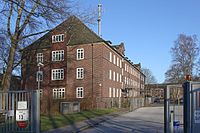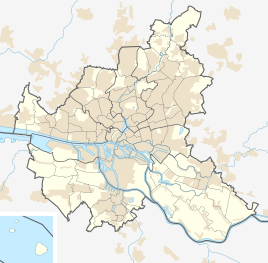Graf Goltz barracks
|
|
|||
|---|---|---|---|

Accommodation building, 2015 use by the Federal Customs Administration |
|||
| country | Germany | ||
| today | Boltwiesen residential area | ||
| local community | Hamburg | ||
| Coordinates : | 53 ° 36 ' N , 10 ° 10' E | ||
| Opened | 1936 | ||
| Old barracks names | |||
| 1945-1951 | Arborfield Barracks, later Adams Barracks |
|
|
| Formerly stationed units | |||
| before 1993: parts of the 6th Panzer Grenadier Division before 1951: parts of the British Rhine Army before 1945: parts of the 20th Infantry Division |
|
||
|
Location of the Graf Goltz barracks in Hamburg |
|||
The Graf-Goltz-Kaserne was a barracks complex in Hamburg-Rahlstedt , which was used for military purposes from 1936 to 1992. A large part of the site was built on with houses after 1993.
history
The barracks were built during the armament of the Wehrmacht from 1936 to 1938 on an area of more than 15 hectares on the eastern edge of Rahlstedt. It was named after Rüdiger von der Goltz . The most striking structure of the complex was the gate system, the pillars of which showed pictures of the invasion of German troops in Prague and the occupation of Brest-Litovsk , which were built in 1939, at the beginning of the Second World War . The pictures were intended to remind of the participation of the 76th Infantry Regiment stationed in Hamburg in the occupation of Brest-Litovsk. The barracks was almost axially symmetrical to the gate and the square directly behind it with a small monument.
Since 1949, the Geyer-Filmkopierwerke used a former accommodation building in the eastern part of the site. The barracks was used by the British Army after the Second World War , handed over to the Federal Border Guard in 1951 and a few years later to the German Armed Forces . Over the use by the armed forces (mainly through parts of Panzergrenadierbrigade 17 ) emerged in the western and northern parts of some modern buildings in the eastern part of a practice area and on the north side a direct access road to the former training area Höltigbaum .
The barracks were finally closed on September 30, 1992 as the Bundeswehr was downsizing.
Reuse
After the barracks were cleared in 1992, some buildings on "Sieker Landstrasse" were temporarily used as accommodation for asylum seekers.
The buildings were largely demolished in 1999, and a building on Sieker Landstrasse was converted and used as a student residence. The main part of the site was converted into the Boltwiesen residential area , which comprises 470 single and terraced houses. A political discussion developed about the preservation of the gate system, which ended in 1999 with the decision of the Hamburg city council to demolish the gate. In the area of the former gate, a row of shops with shops for daily needs was built directly on Sieker Landstrasse .
The Geyer-Filmkopierwerke building was in the eastern part until it was demolished in 2014.
in the western part, parts of the facility were taken over and converted by the Federal Customs Administration in the 1990s . One of the original accommodation blocks, some buildings from the 1970s and some vehicle hangars have since been home to the headquarters of the Hamburg customs investigation office .
photos
Trivia
For the crime scene: Opportunity Makes Love (1984) with Manfred Krug as Commissioner Stoever , the barracks served as a filming location for the Bundeswehr scenes.
Individual evidence
- ^ Entry on Arborfield Barracks on a website about the British Army of the Rhine . Retrieved December 30, 2014.
- ↑ a b c d Article in the world of September 6, 1999. Retrieved January 5, 2015.
- ↑ Photo of the entrance gate from the 1940s on hamburg-bildarchiv.de . Retrieved January 5, 2015.
- ↑ Address ( Memento of the original from March 22, 2015 in the Internet Archive ) Info: The archive link was inserted automatically and not yet checked. Please check the original and archive link according to the instructions and then remove this notice. the Customs Investigation Office Hamburg zoll.de . Retrieved January 5, 2015.
literature
- Oliver Wolf: Dealing with barracks from the time of National Socialism in the preservation of monuments . TU Berlin, Institute for Building History, Berlin ( baugeschichte.a.tu-berlin.de [PDF; accessed on January 5, 2015] after 1999).
- State Office for Geoinformation and Surveying (Ed.): Hamburg in aerial photographs and pictures, 1964 to 2012 . Sutton Verlag, Erfurt 2013, ISBN 978-3-95400-165-1 , p. 135 .
Web links
- MGFA.de - location database of the Military History Research Office Potsdam (units stationed in the Graf-Goltz-Kaserne can be reached by searching for postcode 22143)
- Description on panzergrenadierbrigade17.de .





